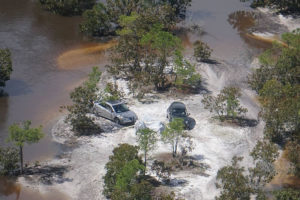
By Andy Brack | Despite naysayers who don’t believe the state’s climate is changing, state government has warmed to the idea that it needs to plan for future weather events that can change lives as quickly as flooding rips apart lives.
On Thursday, the state released a 708-page resiliency plan with 54 recommendations for it to grapple with future impacts of rising air temperatures, rising sea temperatures, more rain, more flooding and more devastating storms.
“This is a project that’s not going to begin today and end in a year or so,” Gov. Henry McMaster said during a Thursday press conference. “This is something that will be a permanent part of life in South Carolina.”
Implementing the recommendations won’t be cheap. In the 2023-24 budget, the state has reserved $200 million to boost resilience. Half of the recommendations in the report would cost $24 million in first-year costs, but the other half, including the possibility of a voluntary buyout program for homes in flood-prone areas, could cost billions.
What the future looks like

The plan outlines ways South Carolina can get ready for weather projections of hotter days, more rain, more storms and rising seas that people already are feeling. Among the carefully worded but key weather-related findings of the report that are likely to have a major impact on South Carolina’s future:
Temperature: South Carolina temperatures have gone up only about 1 degree since 1895, but “climate models project South Carolina temperature increases of 5 degrees to 10 degrees Fahrenheit by the year 2100, depending on future greenhouse gas emissions.”
Precipitation: The state’s rainfall varies, but summers have fewer rainy days and falls have more. “Rising temperatures in the 21st century will likely exacerbate agricultural and hydrologic drought.”
Storms: Because the state is vulnerable to hurricanes, “future scenarios … consistently project greater intensity of wind and precipitation for those storms that do occur.”
Sea-level rise: Because South Carolina’s coast is low-lying, it’s vulnerable to sea rise. Levels have risen by about 1 foot in recent years and could rise another foot by 2050.
Planning to deal with weather impacts
Those who wrote South Carolina’s resiliency plan used the following summary to guide its work: “[Resilience is] the ability of communities, economies and ecosystems within South Carolina to anticipate, absorb, recover and thrive when presented with environmental change and natural hazards.”

In a nutshell, areas with resilient infrastructure and other systems are able to anticipate and bounce back quicker than less reliant systems. But developing resiliency takes planning, money and time, experts say.
“You are correct in your emphasis on measures needed to build a robust, adaptive system, but time is not on your side,” writes Fred Palm, an Edisto Island resident who is a retired professor of oversight and investigations as well as a former executive director of the Association of Inspectors General. “Your plans will disappear in a flash in the next big storm.”
His comments, directed to S.C. Office of Resilience Planning Director Alex Butler, urged rapid deployment of the report’s recommendations: “Move like lightning on stuff you can implement, even if it is not so neat. Get real victories from the start.”
Palm also urged the state to make sure to educate local officials on the threat so they can beef up their resiliency efforts: “It is the elected officials that are sleepwalking and unwilling. The primary target of the education program needs to be the local councils. It is the county officials succumbing to the dream of growth that is corrupting the natural defenses” of South Carolina ecosystems.
Four score and six recommendations
According to the new report, it would cost $10.4 million a year plus $14 million in upfront or construction costs to implement 26 of the 54 recommendations. But those numbers are not indicative of the mammoth cost to boost resiliency as fully envisioned in the plan. Why? The voluntary pre-disaster buyout idea.

Establishment of a voluntary pre-disaster buyout program to “allow the state to be proactive rather than reactive to reduce the risk of future losses,” would cost billions. According to Appendix H of the plan, there are about 68,000 residential properties in flood hazard areas. They are worth $13.7 billion. In a voluntary buyout program, the state ideally would pay people for property and have them move from risky areas to reduce risks and improve resilience.
But Butler admitted during the Thursday conference that buyouts were a touchy subject, as reported by WCSC TV: “It’s a very delicate topic, right? It’s a very detailed topic to look at. There’s a lot of things to consider.
“There’s an attachment to place. Some folks have lived in communities for generations, and there’s a very strong attachment to place. So you have to work with the communities early on to let them know what you know and try to work to solutions that everybody can live with.”
Among nine other categories of recommendations in the report:
- Improve data collection and coordination. Examples: Get more weather stations (Palm suggests turning each school into a weather state and having it provide STEM education to students); do a state sediment study; analyze current zoning and land use policies statewide; and complete the state’s flood inundation modeling and mapping.
- Education outreach and disclosure. This includes having regional planning worships, developing a resilience training program and reestablishing a program for flood hazard signage.
- Watershed-based planning.
- Incorporating resilience concepts into planning and land use practices and processes.
- Maintaining and strengthening building codes.
- Incorporating resilience concepts into design, construction and maintenance of infrastructure.
- Promoting conservation of natural resources to maintain natural environmental protections.
- Incorporating resilience into housing, such as cutting use of manufactured housing units and boosting elevation standards.
- Identifying more funding sources.
For more information, read the plan here.
- Have a comment? Send to: feedback@charlestoncitypaper.com



The States of South Carolina, Georgia, and Florida, Mississippi, Louisiana, and Alabama, are the watersheds of eastern America. The wetlands historically have flooded year after year before the railroads were built. Before man expanded westward. There is a map in the Columbia Museum that depicts the level of the sea a one point in the history of our state. Creating a 708 page resiliency plan with 54 recommendations tells me one thing. The progress federal government has been injected into the administration of this so called resiliency plan.